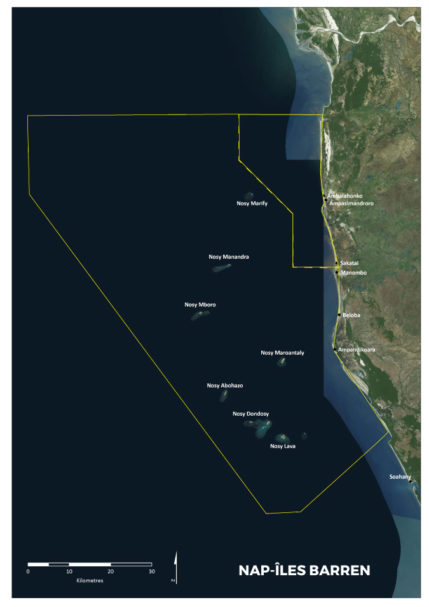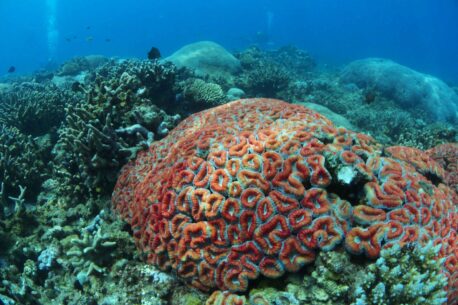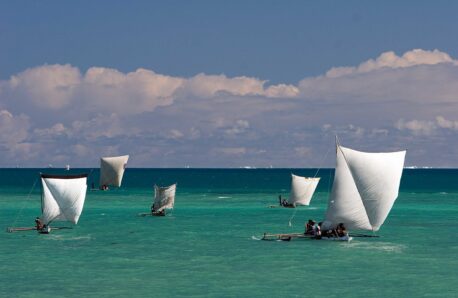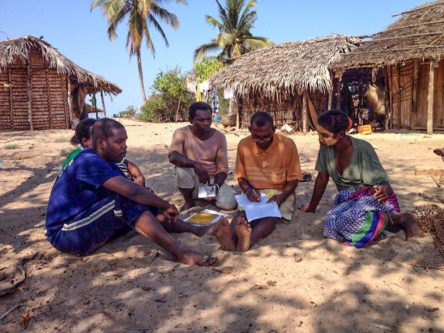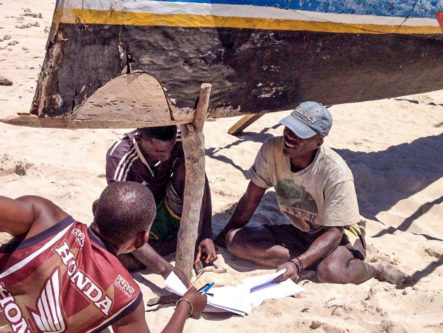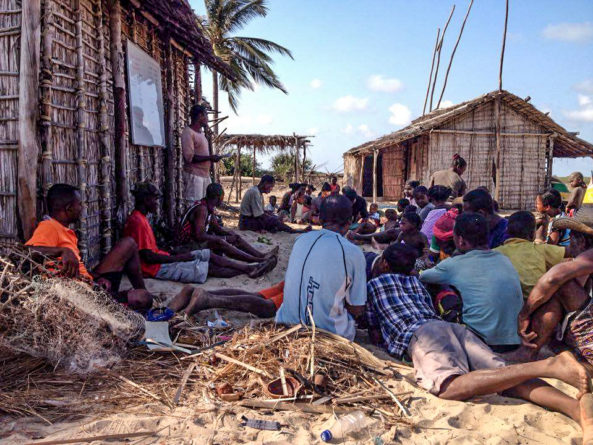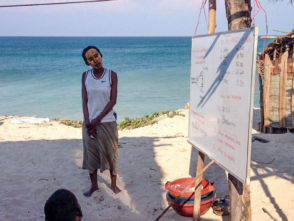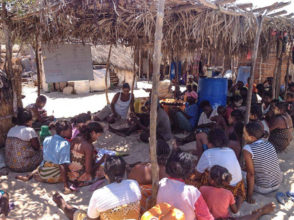The Barren Isles archipelago is one of the few remaining strongholds of thriving marine biodiversity in the western Indian Ocean. Lying off the west coast of Madagascar and home to some of the region’s healthiest coral reefs, this diverse ecosystem supports the livelihoods of more than 4,000 traditional fishers. Many of these fishers migrate to the Barren Isles seasonally, covering up to 1,000 km in outrigger pirogues, in response to declining fisheries elsewhere.
For four years Blue Ventures, the Ministry of Marine Resources and Fisheries, and the Ministry of Environment, Ecology, Sea and Forests in Madagascar have been working together to establish a Locally Managed Marine Area (LMMA) around the Barren Isles, with the aim of reducing pressures on the marine resources.
In 2014, the Government of Madagascar granted a two-year preliminary protected status, making the Barren Isles the country’s largest protected area. The Vezo Miray Nosy Barren Association (hereafter “Vezo Miray”), supported by Blue Ventures, was created to co-manage this new LMMA, and many conservation programmes were introduced, including a fin fish monitoring programme.
The aim of this monitoring programme is to collect long term data on the Barren Isles fisheries, enabling the LMMA co-managers to make sustainable decisions. It was first implemented in Maintirano four years ago, and has recently expanded to cover three new islands, Nosy Lava, Nosy Maroantaly and Nosy Marify, as well as the coastal village of Ampandikoara. We regularly present the results of the programme to the fishing communities using a series of engaging dissemination activities, and these were recently carried out for the first time at these four new sites…
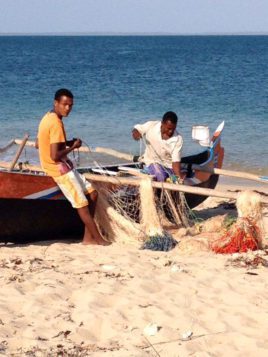
It’s 7am on Nosy Marify, the sun is already quite high in the sky, and the fishers are all sitting in a circle on the beach either eating their breakfast or repairing their nets. Kaka, one of the fin fish monitoring team, is in the middle of preparing our own breakfast, and Toalidy is discussing the presentation schedule with representatives from the Vezo Miray. Today is the day of the dissemination meeting, and we all want it to go well.
Entry from the Mission Logbook during the visit to Nosy Marify in the Barren Isles.
The main aim of our mission was to present the results of the 2015 fin fish monitoring season in the four new sites. However we also had a second aim, which was to strengthen the community understanding of the importance of the monitoring programme, and its connection to the management of the LMMA.
Recently we heard that there were some rumours and mistrust spreading in certain communities using the Barren Isles, saying that the monitoring programme will lead to fishing of certain species being banned. In a place where access to reliable information is very hard for fishers, it is easy to see how these rumours can spread, and we need to maintain regular open dialogues with all communities to counter this. This issue exemplifies why the dissemination mission is so important, as communication is key to developing trust and fellowship within the Barren Isles.
The mission team stayed in each of the four sites for two days, relying on the hospitality of the Vezo Miray, the fin fish surveyors, and the villagers. To maximise the number of fishers present on the Barren Isles these site visits were planned for October and November, which are usually the best fishing months.
During our visit to Nosy Maroantaly, some fishers caught a “vango” (milkfish), a species that they had never caught before. At dinner that night they shared pieces of it with many families and with our team. They also invited us to play beach soccer with them in the sunset.
Planning an effective mission to the Barren Isles is not without its challenges… Our mission started a week late, because most of the fishers we were planning to visit had travelled to the mainland to attend traditional events in respect of the ancestors.
The weather can also be a challenge – whether good or bad. It can be very difficult to arrange meetings on the Barren Isles if the weather is good, because the villagers go fishing in the afternoon at around 3pm and come back the next morning at 10am. During the night, they fish with kirara (long eight-finger mesh nets targeting pelagic fishes), and during the day, they catch ‘Antseraky’ (needlefish) or glean for octopus. We were fortunate that during this mission a ‘tsioky antimo’ (Southern wind) was blowing, so the fishers were not able to go out as much. This gave us time to have the dissemination meetings without rushing, and with maximum fisher participation and engagement.
At each new site the the mission team would meet with the data surveyors and listen to their feedback, before going door to door through the village, sharing information and ideas with the fishers, and encouraging them to come to the dissemination meeting.
In Nosy Maroantaly the total catch from May to November 2015 was recorded at almost six tonnes, and Namakia was the main fishing site. In Ampandikoara, the most popular fishing technique during 2015 was to use nets between 3 and 1 fingers in mesh size.
Once all the villagers were gathered for the meeting, one of the surveyors would present the results of the monitoring season across all four sites, including the total overall catch, the most popular fishing sites, the most popular fishing techniques, and the largest data sample caught in one day.
The Vezo Miray representatives would then explain the importance of analysing this data over time, and using the results to influence the management of the LMMA and ensure the long term sustainability of the fish stocks.
The third part of each meeting was more of a fun activity where the villagers were asked quiz questions about the presentations and about resources management. Villagers were selected at random to answer the questions, and received prizes regardless of whether their answer was correct. The prizes were mostly items needed daily on the Barren Isles, such as ‘lambahoany’ (a traditional malagasy piece of cloth) or basins.
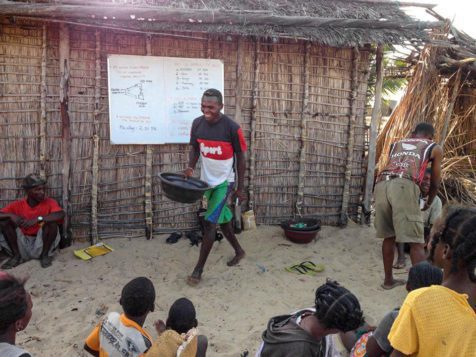
Basins being handed out as prizes for the quiz
The villagers initially struggled with some of the topics, but we found that by asking the right questions we were able to encourage them to speak out about issues that are important to them.
For example, when we asked them “can you see any threats to your marine resources?”, many of the villagers mentioned that the increase in numbers of fishermen visiting the islands was becoming a serious problem, and that a management solution was needed.
We also asked them how we could improve the fin fish monitoring process, and received some very useful feedback. We discovered that one fisher from Ampandikoara did not believe the results given in the presentation because there were gaps in the data. Many of the fishers at the meeting were inspired by this to prevent future data gaps in by submitting their catch to the monitoring programme. This feedback also motivated the surveyors to continue their good work and to not be discouraged by adversity.
The interest and enthusiasm of the fishing communities was not only essential for the success of this mission, but is also a very positive sign for the Barren Isles LMMA. It is clear that they are invested in the future of their fisheries, and how crucially important it is to keep reminding them about the long-term goals of the fin fish monitoring programme. This is an exciting new chapter for the Barren Isles LMMA, and we’re already looking forward to the next mission which we hope will be equally successful!
We would like to thank our funders for their support, including: the GEF through UNEP under the Dugong and Seagrass Project, the Critical Ecosystem Partnership Fund and the Darwin Initiative through UK Government funding. Special thanks also to the fin fish surveyors and the Vezo Miray representatives from each site for their hard work and hospitality.


